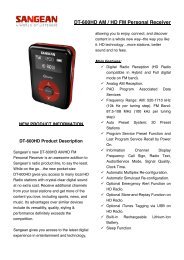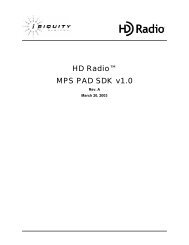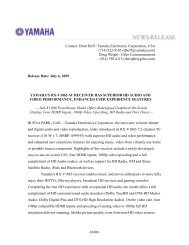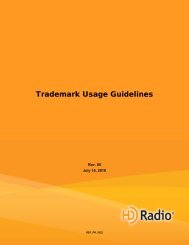The Structure and Generation of Robust Waveforms ... - iBiquity Digital
The Structure and Generation of Robust Waveforms ... - iBiquity Digital
The Structure and Generation of Robust Waveforms ... - iBiquity Digital
Create successful ePaper yourself
Turn your PDF publications into a flip-book with our unique Google optimized e-Paper software.
to select the data services desired<br />
<strong>and</strong> when they are presented. This<br />
provides personalized, on-dem<strong>and</strong>,<br />
user-valued information.<br />
• Station Identification Service (SIS)<br />
<strong>The</strong> Station Identification Service provides<br />
the necessary control <strong>and</strong> identification<br />
information, which indirectly accommodates<br />
user search <strong>and</strong> selection <strong>of</strong> IBOC digital<br />
radio stations <strong>and</strong> their supporting services.<br />
• Auxiliary Application Service (AAS)<br />
This service allows a virtually unlimited<br />
number <strong>of</strong> custom <strong>and</strong> specialized IBOC<br />
digital radio applications to co-exist<br />
concurrently. Auxiliary applications can be<br />
added at any time in the future.<br />
Support <strong>of</strong> the above services is provided via a<br />
layered protocol stack illustrated in Figure 1.<br />
This layered protocol stack is based on the<br />
International St<strong>and</strong>ards Organization Open<br />
Systems Interconnection (ISO OSI) layered<br />
model 1 . Layer 5 (Application) accepts content<br />
from the user (i.e. program source). Layer 4<br />
(Encoding) performs the necessary audio<br />
compression or data formatting <strong>of</strong> the various<br />
source materials. Layer 3 (Transport) provides<br />
one or more application specific protocols<br />
tailored to provide robust <strong>and</strong> efficient transfer <strong>of</strong><br />
Layer 4 data. Layer 2 (Service Mux) provides<br />
limited error detection <strong>and</strong> addressing. Its main<br />
function is to format the data received from<br />
Layer 3 into discrete transfer frames for<br />
processing by Layer 1. Layer 1 (Physical<br />
Layer) provides the modulation, FEC, framing,<br />
<strong>and</strong> signaling necessary to convert the digital<br />
data received from higher layers into an AM<br />
IBOC waveform for transmission in an existing<br />
allocation in the MF b<strong>and</strong>.<br />
This paper focuses on Layer 1 <strong>of</strong> the AM IBOC<br />
system. Layer 1 can be thought <strong>of</strong> as simply a<br />
“pipe” to broadcast data with a specific grade <strong>of</strong><br />
service; the source coding, formatting <strong>and</strong><br />
multiplexing <strong>of</strong> the program content performed<br />
at the higher protocol layers. However, the AM<br />
IBOC system provides a number <strong>of</strong> different<br />
configurations, called service modes, in which<br />
the number, throughput <strong>and</strong> robustness <strong>of</strong> the<br />
“data pipes,” called logical channels, can vary.<br />
<strong>The</strong>refore, after assessing the requirements <strong>of</strong><br />
their c<strong>and</strong>idate applications, higher protocol<br />
layers select service modes that most suitably<br />
configure the logical channels. <strong>The</strong> plurality <strong>of</strong><br />
logical channels <strong>and</strong> service modes reflects the<br />
inherent flexibility <strong>of</strong> the system, which supports<br />
simultaneous delivery <strong>of</strong> various classes <strong>of</strong><br />
digital audio <strong>and</strong> data.<br />
Layer 5 (Application)<br />
Layer 4 (Encoding)<br />
Layer 3 (Transport)<br />
Layer 2 (Service Mux)<br />
Layer 1 (Physical)<br />
Main Program Service<br />
(MPS)<br />
L5 MPS L5 MPS<br />
Audio Data<br />
L4 MPS<br />
PAC<br />
L3 MPS<br />
L4 MPS<br />
Data<br />
Formatting<br />
Station<br />
Identification<br />
Service (SIS)<br />
SIS Data<br />
L4 SIS<br />
Data<br />
Formatting<br />
L3 SIS<br />
L2 Service Multiplexer<br />
L1 Physical<br />
Others<br />
(PDS,AAS)<br />
Figure 1 IBOC protocol stack.<br />
<strong>The</strong> remaining sections <strong>of</strong> this paper are<br />
organized as follows. First, the modulation <strong>and</strong><br />
spectral occupancy <strong>of</strong> the waveforms are<br />
described. This is followed by a description <strong>of</strong><br />
the available service modes, as well as the<br />
various broadcaster options within each service<br />
mode. Next, the logical channels in each service<br />
mode are described in terms <strong>of</strong> their throughput,<br />
robustness, <strong>and</strong> latency. Finally, we present the<br />
functional components <strong>of</strong> AM waveform<br />
generation, describing the processing necessary<br />
to convert the digital data in the active logical<br />
channels into an AM IBOC waveform.<br />
WAVEFORMS AND SPECTRA<br />
<strong>Digital</strong> data <strong>and</strong> audio cannot be directly<br />
propagated over RF channels; therefore a<br />
modulator is used to modulate the digital<br />
information onto an RF carrier. <strong>The</strong> AM IBOC<br />
system employs Orthogonal Frequency Division<br />
Multiplexing (OFDM) 2-4 , for robustness in the<br />
presence <strong>of</strong> adjacent channel interference <strong>and</strong><br />
noise. OFDM is a parallel modulation scheme in<br />
which the data streams modulate a large number<br />
<strong>of</strong> orthogonal subcarriers that are transmitted<br />
simultaneously. OFDM can be tailored to fit an<br />
interference environment that is non-uniform<br />
across frequency.<br />
<strong>The</strong> narrow AM b<strong>and</strong>width leads to an OFDM<br />
modulation technique that is optimized for<br />
higher throughput. <strong>iBiquity</strong> <strong>Digital</strong>’s IBOC<br />
technology for AM uses Quadrature Amplitude<br />
Modulation (QAM) on each OFDM subcarrier.<br />
2









